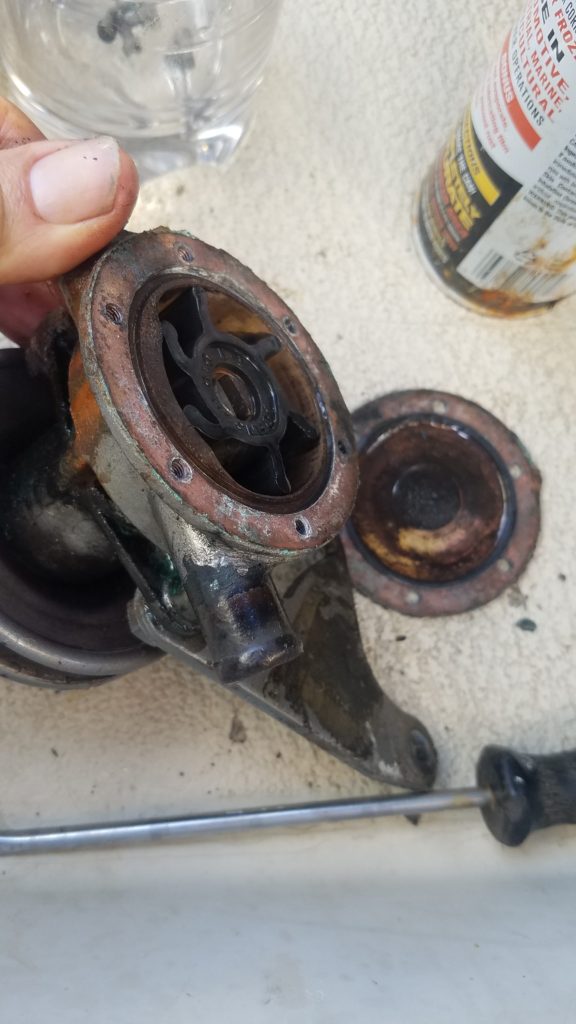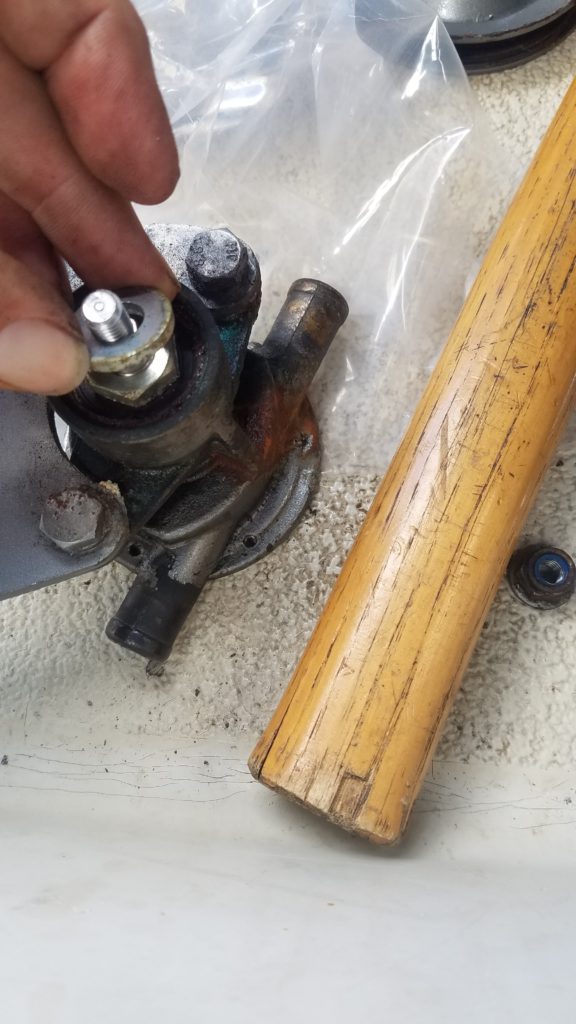Ko Olina Marina, HI, 4-APR-2020 – In the 1980s, the circle I lived in, mostly PhD psychologists of one stripe or another, mixed with some computer scientists, a bunch of neural network people, a physicist or two and who knows who else, looked at the current computer architecture as a model of how the brain works. A homologue for the CPU was easy, RAM was short term memory, disk storage was long term memory, we were certain we all knew how this fit together.
We were sure we were that first to find our current technology explained the least understood mysteries of the human body. A historian in the group pointed out that when pumps were the technology rage, technocrats of the day explained how the human body, including the brain, was just like a series of pumps.
I thought briefly about this when I was rebuilding the impeller pump on Caro Babbo’s three-cylinder Yanmar, and it has floated over me, cautioning me against hubris whenever I contemplate installing the second (which will be the primary) bilge pump.

It finally became an inescapable topic when my friend John Riley succeeded in a two-year quest to buy a boat. I wrote about John last year when he was living in a facility in Tacoma after suffering a stroke.
John was living on his sailboat when he suffered a stroke. The road back was long and the prognosis grim. While he was unconscious his family disposed of his boat, because he was sure to die and there was no need. After a series of surgeries, including open heart, John was aphasic. He could understand, but could not speak. Family and medical care spoke around him, confirming that he was in a vegetative state and was to be written off to a back ward some place.
John and Jennifer are the two bravest people I know. Jennifer has crossed the pacific with me even though she was terrified. John, once he could speak and walk, decided he would not end his days in an institution.
He tells me he was thrown out of rehab when the staff learned he was sneaking off to Burger King to bring back food for a fellow patient who couldn’t. If John could do that he didn’t need rehab.
When I wrote about John a year ago, he as still in the facility. He was well liked and had started gardening, but it is a place where people come to spend the rest of their lives with a roof over their head and three meals a day from cans.
John told us, in addition to not wanting to die in a facility, he wanted to live on a boat.
How? Live in shelters while saving enough money to buy a boat. The homeless can survive in Seattle, and New York for that matter. There are safe places to sleep, places where one can spend time and get help getting a job. Working turned out not to be viable. John’s stoke left him unable to do anything in the way of labor, and has damaged his speech enough that he is not employable in jobs where he must speak: a pity, he is a good teacher.
The Corona virus damaged the viability of being homeless in the cold: The places the homeless would visit, day shelters, libraries, and coffee shops are all closed. It also depressed boat prices. Yesterday, John bought a Cal 27 Mark III, a well-regarded vessel.
On Caro Babbo, John learned he can sail, row a dinghy and move slowly around a deck: He can live on a sailboat.
After some correspondence and a visit or two, John gathered his funds and bought his boat. The stuffing box is dripping a bit, but the bilge pumps work well and the engine starts on command. John is afloat.
We spoke about his strategy about where to live – liveaboards on less than forty feet are being discouraged, but there is a very viable strategy that John will pursue. I won’t share it here.
In our discussion yesterday, when John discovered he’d forgotten to check if there was a stove (there isn’t), John asked about rebuilding the impeller pump. This is the pump that pumps water from the outside of the boat (raw water) to cool the engine. Most modern engines use an antifreeze solution inside the engine and a heat exchanger in place of a radiator to pull the engine heat out of the antifreeze solution.
John worries that the impeller in his pump may need to be replaced. It is routine maintenance.
On our crossing from San Diego to Hawaii, our impeller pump started to leak. Here in Hawaii, I replaced the seals and the bearings.
Here in part two of the post is what I did, what was worthwhile and what was not.
As the first time really offshore, we were very uncertain about what was serious and what was not. In a ‘‘plastic’’ boat, the water generally stays easily on the outside of the boat. A dry bilge is common on a fiberglass boat. Caro Babbo is a fiberglass boat.
A wooden boat is a different kettle of fish. Our wooden boat-owning friends declare that every boat is sinking, it is just a matter of how quickly. The determinate is whether the pumps can keep up.
The number of pumps of a modern boat is very surprising. On Caro Babbo they are:
- Fuel pump that pumps from the fuel tank to Newport Diesel fireplace
- Fuel pump that pumps from the fuel tank to the Webasto forced air diesel heater
- Water pump that pressurizes the water running water
- Two fresh water foot pumps for the galley and the head sinks to be used if the pressure system is not working
- Saltwater foot pump to the galley sink. All dishwashing is done with saltwater when we are away from a dock.
- Saltwater pump that is part of the toilet
- Lift pump that pumps the fuel from the fuel tank to the engine: it lifts it to the high pressure injector pump
- High Pressure injector pump that forces fuel through the fuel injectors
- Installed manual bilge pump to pump out the bilge when the electrical pump fails
- Portable manual bilge pump that is used to pump out the sump under the engine when it fills with water. Water enters the sump from the anti-siphon device on the raw water intake hose, from water running down the compression post under the mast and, if the bilge overflows, water will run forward to the sump.
- The, yet uninstalled, diaphragm pump that will become the primary bilge pump because with a hose it can drain the back end of the bilge, which the bulky impeller pump cannot.
- The pump that pressurizes the kerosene for the stove.
- The water pump inside the engine to circulate the coolant
- The high pressure pump inside the water maker
- The hand pump that I use to extract oil from the engine crankcase
- The non-functioning original bilge pump that is in the bilge because it cannot be removed without removing the propeller shaft, which I am not brave enough to do with the boat in the water. I’m contemplating a chisel and hammer solution to remove the Rule-brand centrifugal pump. Comments?
On our crossing, Caro Babbo had two leaks: the impeller pump, which is the pump I just rebuilt, and the propeller shaft seal. The jury is still out on the propeller seal. It became a noticeable problem when the float switch for the bilge pump stopped working because of saltwater intrusion into the connections allowing the bilge to fill and overflow with saltwater. This will be the subject of a follow on post. It was an exciting time because Caro Babbo’s bilge is only two or so gallons.
The impeller pump, like many pumps is comprised of two sections, the drive section, which should be dry and the driven or pumping section, which contains the liquid to be pumped. The two sections are enclosed in distinct housings with a driveshaft connecting the two, and a seal to keep the liquid from the leaving the driven section and O-ring from keeping it from entering the drive section.

The O-ring is pretty useless in this implementation and the seal failed, allowing salt water to leak out of the driven, pump section, which is what we saw. The salt water entered the drive section damaging one of the bearings.

Many thanks to Steve Dracott for his guidance and advice.
The bearings on the shaft spun fine, to my feel, but Steve said the smaller bearing was dry and I did not want to be worried about it when I was sailing. I replied that I hadn’t been worried until he pointed this out to me. Ignorance is bliss. Now with a worry about the one bearing, I replaced both.

I bought a rebuild kit from the manufacturer, Johnson pumps, which was a stunning waste of money. The same part number pump has been built in a number of variants over the years. The kit comes with gaskets and O-rings for all of the variants and two seals – apparently there was a better designed model that had a seal on each side of the pump, drive and driven. My pump had only one seal. All I really needed was a single seal from the kit and nothing else. The kit did include an impeller, which is useful and does do something to warrant the $55 price.
The bearings on the drive side were equally stunning in price, a little over $100 for both. I do not have a commercial account, so I paid full retail. I expect they are half that price wholesale.

The Corona virus was in full swing here in Hawaii by then. Though the woman at the counter did not wear a mask: we stayed six feet from each other. She placed the bearings on the counter. Then I approached the counter to examine them. She had me read my credit card to her, rather than touch it.
The bearings I replaced were all made in Italy. The replacement bearings were made in India and Argentina.
The rebuild is what I expected. A wheel puller and a half-inch long socket were used to remove the shaft from the pump and the bearings from the shaft. In retrospect, if the bearings were not replaced, I believe the seal could have been coached off the shaft from the driven side of the pump and merely pushed back on in a few minutes beyond what it takes to replace the impeller.
With practice, the full rebuild is a twenty-minute job. It took me more than two hours. Installed, the pump does not leak and works well.
For the last week or so, I have been preparing a fisheries supply order to work on the many projects Caro Babbo requires. There are only one or two that must be done before we could sail off, and many, many that would be nice to have done, and then, well, the unending list of things that should be done.
I have also reinstalled the boom, after receiving the new sheaves and updated bearings (a follow-on article), spliced up a few soft shackles, done a little eye-splicing for the boom vang, and on and on. I keep to to-do list on the app, 2Do (I recommend 2Do highly). The list not only allows me to track what needs to be done, it allows me to have a sense of accomplishment for what I have actually finished.
Stay safe.

